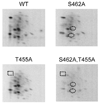Phosphorylation of human CTP synthetase 1 by protein kinase C: identification of Ser(462) and Thr(455) as major sites of phosphorylation
- PMID: 17463002
- PMCID: PMC2081159
- DOI: 10.1074/jbc.M702799200
Phosphorylation of human CTP synthetase 1 by protein kinase C: identification of Ser(462) and Thr(455) as major sites of phosphorylation
Abstract
Phosphorylation of human CTP synthetase 1 by mammalian protein kinase C was examined. Using purified Escherichia coli-expressed CTP synthetase 1 as a substrate, protein kinase C activity was time- and dose-dependent and dependent on the concentrations of ATP and CTP synthetase 1. The protein kinase C phosphorylation of the recombinant enzyme was accompanied by a 95-fold increase in CTP synthetase 1 activity. Phosphopeptide mapping and phosphoamino acid analyses showed that CTP synthetase 1 was phosphorylated on multiple serine and threonine residues. The induction of PKC1(R398A)-encoded protein kinase C resulted in a 50% increase for human CTP synthetase 1 phosphorylation in the Saccharomyces cerevisiae ura7Delta ura8Delta mutant lacking yeast CTP synthetase activity. Synthetic peptides that contain the protein kinase C motif for Ser(462) and Thr(455) were substrates for mammalian protein kinase C, and S462A and T455A mutations resulted in decreases in the extent of CTP synthetase 1 phosphorylation that occurred in vivo. Phosphopeptide mapping analysis of S. cerevisiae-expressed CTP synthetase 1 mutant enzymes phosphorylated with mammalian protein kinase C confirmed that Ser(462) and Thr(455) were phosphorylation sites. The S. cerevisiae-expressed and purified S462A mutant enzyme exhibited a 2-fold reduction in CTP synthetase 1 activity, whereas the purified T455A mutant enzyme exhibited a 2-fold elevation in CTP synthetase 1 activity (Choi, M.-G., and Carman, G.M. (2006) J. Biol. Chem. 282, 5367-5377). These data indicated that protein kinase C phosphorylation at Ser(462) stimulates human CTP synthetase 1 activity, whereas phosphorylation at Thr(455) inhibits activity.
Figures









Similar articles
-
Phosphorylation of human CTP synthetase 1 by protein kinase A: identification of Thr455 as a major site of phosphorylation.J Biol Chem. 2007 Feb 23;282(8):5367-77. doi: 10.1074/jbc.M610993200. Epub 2006 Dec 22. J Biol Chem. 2007. PMID: 17189248 Free PMC article.
-
Phosphorylation of CTP synthetase on Ser36, Ser330, Ser354, and Ser454 regulates the levels of CTP and phosphatidylcholine synthesis in Saccharomyces cerevisiae.J Biol Chem. 2003 Jun 6;278(23):20785-94. doi: 10.1074/jbc.M301394200. Epub 2003 Apr 1. J Biol Chem. 2003. PMID: 12670958
-
Expression of Human CTP synthetase in Saccharomyces cerevisiae reveals phosphorylation by protein kinase A.J Biol Chem. 2005 Nov 18;280(46):38328-36. doi: 10.1074/jbc.M509622200. Epub 2005 Sep 22. J Biol Chem. 2005. PMID: 16179339 Free PMC article.
-
CTP synthetase and its role in phospholipid synthesis in the yeast Saccharomyces cerevisiae.Prog Lipid Res. 2008 Sep;47(5):333-9. doi: 10.1016/j.plipres.2008.03.004. Epub 2008 Apr 7. Prog Lipid Res. 2008. PMID: 18439916 Free PMC article. Review.
-
Phospholipid synthesis in yeast: regulation by phosphorylation.Biochem Cell Biol. 2004 Feb;82(1):62-70. doi: 10.1139/o03-064. Biochem Cell Biol. 2004. PMID: 15052328 Review.
Cited by
-
A CTP Synthase Undergoing Stage-Specific Spatial Expression Is Essential for the Survival of the Intracellular Parasite Toxoplasma gondii.Front Cell Infect Microbiol. 2018 Mar 22;8:83. doi: 10.3389/fcimb.2018.00083. eCollection 2018. Front Cell Infect Microbiol. 2018. PMID: 29623259 Free PMC article.
-
The TOR pathway modulates cytoophidium formation in Schizosaccharomyces pombe.J Biol Chem. 2019 Oct 4;294(40):14686-14703. doi: 10.1074/jbc.RA119.009913. Epub 2019 Aug 19. J Biol Chem. 2019. PMID: 31431504 Free PMC article.
-
Ubiquitination and filamentous structure of cytidine triphosphate synthase.Fly (Austin). 2016 Jul 2;10(3):108-14. doi: 10.1080/19336934.2016.1182268. Epub 2016 Apr 26. Fly (Austin). 2016. PMID: 27116391 Free PMC article.
-
GTP-Dependent Regulation of CTP Synthase: Evolving Insights into Allosteric Activation and NH3 Translocation.Biomolecules. 2022 Apr 29;12(5):647. doi: 10.3390/biom12050647. Biomolecules. 2022. PMID: 35625575 Free PMC article. Review.
-
Common regulatory control of CTP synthase enzyme activity and filament formation.Mol Biol Cell. 2014 Aug 1;25(15):2282-90. doi: 10.1091/mbc.E14-04-0912. Epub 2014 Jun 11. Mol Biol Cell. 2014. PMID: 24920825 Free PMC article.
References
-
- Stryer L. Biochemistry. Fourth Ed. New York: W. H. Freeman and Company; 1995.
-
- Aronow B, Ullman B. J. Biol. Chem. 1987;262:5106–5112. - PubMed
-
- Robert de Saint Vincent B, Buttin G. Biochim. Biophys.Acta. 1980;610:352–359.
-
- Ozier-Kalogeropoulos O, Fasiolo F, Adeline M-T, Collin J, Lacroute F. Mol.Gen.Genet. 1991;231:7–16. - PubMed
Publication types
MeSH terms
Substances
Grants and funding
LinkOut - more resources
Full Text Sources
Molecular Biology Databases

